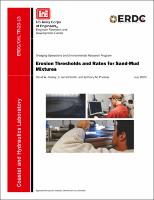Please use this identifier to cite or link to this item:
https://hdl.handle.net/11681/37495Full metadata record
| DC Field | Value | Language |
|---|---|---|
| dc.contributor.author | Perkey, David W. | en_US |
| dc.contributor.author | Smith, S. Jarrell | en_US |
| dc.contributor.author | Priestas, Anthony M. | en_US |
| dc.creator | Coastal and Hydraulics Laboratory (U.S.) | en_US |
| dc.creator | Dredging Operations and Environmental Research Program (U.S.) | en_US |
| dc.date.accessioned | 2020-07-21T17:31:11Z | en_US |
| dc.date.available | 2020-07-21T17:31:11Z | en_US |
| dc.date.issued | 2020-07 | en_US |
| dc.identifier.govdoc | ERDC/CHL TR-20-13 | en_US |
| dc.identifier.uri | https://hdl.handle.net/11681/37495 | en_US |
| dc.identifier.uri | http://dx.doi.org/10.21079/11681/37495 | en_US |
| dc.description | Technical Report | en_US |
| dc.description.abstract | Differences in erosion behavior of non-cohesive and cohesive sediments are widely recognized. In many natural environments, sand and mud are not completely separated and occur as mixtures. Significantly less research has been conducted on the erosion behavior of sand-mud mixtures compared to the separate treatment of sand and mud erosion. Sedflume erosion experiments were conducted on sand-mud mixtures with varying mud content to define the relationships between mud content, critical stress for erosion (τc), and erosion rate. Sand-mud mixtures were prepared with three mud sources: (1) non-swelling clay (kaolinite), (2) swelling clay (kaolinite/bentonite), and (3) a swelling, natural mud from the Mississippi River. Test results showed that critical shear stresses of the mixed sediments departed from that of pure sand with mud fractions on the order of 2% to 10%. Peak τc was observed between 30% to 40% mud content, with swelling muds achieving a ten-fold increase in τc while a five-fold increase in τc was measured for kaolinite. Additionally, this study demonstrated that the introduction of small amounts (≤5%) of mud to sand reduced erosion rates by a factor of 10 to 100. This observed abatement of erosion rate has implications for the use of dredged materials in civil and environmental engineering projects. | en_US |
| dc.description.sponsorship | Prepared for Dredging Operations and Environmental Research Program Vicksburg, MS 39180 under Project No. 485304, “Cost Effective Stabilization of Dredged Sediment for Capping and Nearshore Placement” | en_US |
| dc.description.tableofcontents | Abstract .................................................................................................................................... ii Figures and Tables .................................................................................................................. iv Preface ..................................................................................................................................... x 1 Introduction ...................................................................................................................... 1 1.1 Background ........................................................................................................ 1 1.2 Objective(s) ........................................................................................................ 1 1.3 Approach ............................................................................................................ 2 2 Methods ............................................................................................................................ 3 2.1 Sediment properties .......................................................................................... 3 2.2 Erosion testing ................................................................................................... 7 2.2.1 Sediment Erosion with Depth flume (Sedflume) ....................................................... 7 2.2.2 Slurry preparation ....................................................................................................... 9 2.2.3 Core preparation ......................................................................................................... 9 2.3 Physical properties ......................................................................................... 13 2.3.1 Grain size ................................................................................................................... 13 2.3.2 Bulk density ............................................................................................................... 13 2.3.3 Atterberg limits .......................................................................................................... 14 3 Results ............................................................................................................................. 15 3.1 Physical properties of test materials ..............................................................15 3.1.1 Atterberg limits .......................................................................................................... 15 3.1.2 Bulk density ............................................................................................................... 17 3.1.3 Grain size ................................................................................................................... 20 3.2 Erosion tests ................................................................................................... 22 3.2.1 Erosion parameterization ......................................................................................... 22 3.2.2 Sediment erosion rates ............................................................................................ 29 4 Summary and Conclusions ........................................................................................... 32 5 Future Work .................................................................................................................... 34 References ............................................................................................................................. 36 Appendix A: Grain Size Data ................................................................................................ 39 Appendix B: X-Ray Attenuation Bulk Density Plots .......................................................... 52 Appendix C: Erosion Data .................................................................................................... 57 Acronyms and Abbreviations ............................................................................................... 82 Report Documentation Page | en_US |
| dc.format.extent | 96 pages/10.16 MB | en_US |
| dc.format.medium | en_US | |
| dc.language.iso | en_US | en_US |
| dc.publisher | Engineer Research and Development Center (U.S.) | en_US |
| dc.relation.ispartofseries | Technical Report (Engineer Research and Development Center (U.S.)) ; no. ERDC/CHL TR-20-13 | en_US |
| dc.rights | Approved for Public Release; Distribution is Unlimited | en_US |
| dc.source | This Digital Resource was created in Microsoft Word and Adobe Acrobat | en_US |
| dc.subject | Dredging | en_US |
| dc.subject | Dredging spoil | en_US |
| dc.subject | Erosion | en_US |
| dc.subject | Mud | en_US |
| dc.subject | Sand | en_US |
| dc.subject | Dredging Operations and Environmental Research Program (U.S.) | en_US |
| dc.title | Erosion thresholds and rates for sand-mud mixtures | en_US |
| dc.type | Report | en_US |
| Appears in Collections: | Technical Report Technical Report | |
Files in This Item:
| File | Description | Size | Format | |
|---|---|---|---|---|
| ERDC-CHL TR-20-13.pdf | ERDC/CHL TR-20-13 | 10.16 MB | Adobe PDF |  View/Open |